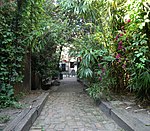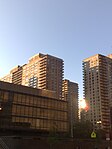Eleanor Roosevelt Monument
1996 sculpturesMonuments and memorials in ManhattanMonuments and memorials to Eleanor RooseveltNew York (state) sculpture stubsOutdoor sculptures in Manhattan ... and 3 more
Riverside Park (Manhattan)Statues in New York CityUpper West Side
The Eleanor Roosevelt Monument is a memorial located in New York City's Riverside Park, whose centerpiece is a statue of Eleanor Roosevelt, said to be the first monument dedicated to an American president's wife. Hillary Clinton (First Lady at the time) gave the keynote address at the monument's October 1996 dedication.
Excerpt from the Wikipedia article Eleanor Roosevelt Monument (License: CC BY-SA 3.0, Authors).Eleanor Roosevelt Monument
West 72nd Street, New York Manhattan
Geographical coordinates (GPS) Address External links Nearby Places Show on map
Geographical coordinates (GPS)
| Latitude | Longitude |
|---|---|
| N 40.78065 ° | E -73.98579 ° |
Address
Eleanor Roosevelt Monument
West 72nd Street
10069 New York, Manhattan
New York, United States
Open on Google Maps








